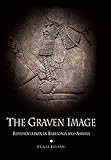The Graven Image : Representation in Babylonia and Assyria / Zainab Bahrani.
Material type: TextSeries: Archaeology, Culture, and SocietyPublisher: Philadelphia : University of Pennsylvania Press, [2011]Copyright date: ©2003Description: 1 online resource (256 p.) : 28 illusContent type:
TextSeries: Archaeology, Culture, and SocietyPublisher: Philadelphia : University of Pennsylvania Press, [2011]Copyright date: ©2003Description: 1 online resource (256 p.) : 28 illusContent type: - 9780812236484
- 9780812206777
- 302.20935
- BH102 ǂb B34 2003eb
- online - DeGruyter
- Issued also in print.
| Item type | Current library | Call number | URL | Status | Notes | Barcode | |
|---|---|---|---|---|---|---|---|
 eBook
eBook
|
Biblioteca "Angelicum" Pont. Univ. S.Tommaso d'Aquino Nuvola online | online - DeGruyter (Browse shelf(Opens below)) | Online access | Not for loan (Accesso limitato) | Accesso per gli utenti autorizzati / Access for authorized users | (dgr)9780812206777 |
Browsing Biblioteca "Angelicum" Pont. Univ. S.Tommaso d'Aquino shelves, Shelving location: Nuvola online Close shelf browser (Hides shelf browser)

|

|

|

|

|

|

|
||
| online - DeGruyter Tax and Spend : The Welfare State, Tax Politics, and the Limits of American Liberalism / | online - DeGruyter Between Christian and Jew : Conversion and Inquisition in the Crown of Aragon, 1250-1391 / | online - DeGruyter Bodies of Belief : Baptist Community in Early America / | online - DeGruyter The Graven Image : Representation in Babylonia and Assyria / | online - DeGruyter Leaderless Jihad : Terror Networks in the Twenty-First Century / | online - DeGruyter Understanding Terror Networks / | online - DeGruyter Heresy and Authority in Medieval Europe / |
Frontmatter -- Contents -- Illustrations -- Introduction -- 1. The Aesthetic and the Epistemic: Race, Culture, and Antiquity -- 2. The Extraterrestrial Orient: Despotic Time and the Time of the Despots -- 3. Ethnography and Mimesis: Representing Aesthetic Culture -- 4. Being in the Word: Of Grammatology and Mantic -- 5. Ṣalmu: Representation in the Real -- 6. Decoys and Lures: Substitution and the Uncanny Double of the King -- 7. Presence and Repetition: The Altar of Tukulti-Ninurta -- 8. Conclusion: Image, Text, and Différance, or from Difference to Différance -- Notes -- Bibliography -- Index -- Acknowledgments
restricted access online access with authorization star
http://purl.org/coar/access_right/c_16ec
Mesopotamia, the world's earliest literate culture, developed a rich philosophical conception of representation in which the world was saturated with signs. Instead of imitating the natural world, representation-both in writing and in visual images-was thought to participate in the world and to have an effect upon it in natural, magical, and supernatural ways. The Graven Image is the first book to explore this tradition, which developed prior to, and apart from, the Greek understanding of representation.The classical Greek system, based on the notion of mimesis, or copy, is the one with which we are most familiar today. The Assyro-Babylonian ontology presented here by Zainab Bahrani opens up fresh avenues for thinking about the concept of representation in general, and her reading of the ancient Mesopotamian textual and visual record in its own ontological context develops an entirely new approach to understanding Babylonian and Assyrian arts in particular.The Graven Image describes, for the first time, rituals and wars involving images; the relationship of divination, the organic body, and representation; and the use of images as a substitute for the human form, integrating this ancient material into contemporary debates in critical theory. Bahrani challenges current methodologies in the study of Near Eastern archaeology and art history, introducing a new way to appreciate the unique contributions of Assyrian and Babylonian culture and their complex relationships to the past and present.
Issued also in print.
Mode of access: Internet via World Wide Web.
In English.
Description based on online resource; title from PDF title page (publisher's Web site, viewed 24. Apr 2022)


